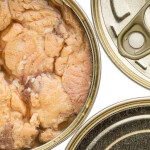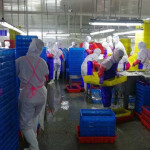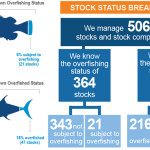U.S. sanctions on Russian imports – announced in March 2022 and meant to punish the country for its invasion of Ukraine – have resulted in Russia diverting large volumes of crab of to East Asian markets, depressing prices.
At the 24th Japan International Seafood Show, held 24 to 26 August in Tokyo, Satoru Kasei, manager of Chairman Room for Tsukiji Kanisho Co. said his company has the largest share of crab in the Japanese market, with most of the product imported from Russia. The company sold crab worth about USD 294 million (EUR 292 million) in 2019. The Tokyo-based company has processing facilities in the Chiba and Ibaraki prefectures in Japan handling mainly king crab, as well as in China and Indonesia for snow crab.
He said the volumes of king and snow crab exported to Japan, South Korea, and China have increased drastically, driving prices down. King crab sections reached a high price of JPY 10,000 (USD 72.71, EUR 72.97) in December of last year, but are now selling at JPY 6,000 (USD 43.63, EUR 43.78). As a rule of thumb, snow crab usually wholesales for half the price of king. Kasei said that it went for JPY 5,000 (USD 36.35, EUR 36.48) last year, but has fallen to JPY 2,500 (USD 18.18, EUR 18.24) this year.
December is typically when the peak price occurs because many people enjoy a crab hotpot (kani-nabe) with family during Japan’s New Year holidays.
Russian crabbing vessels used to deliver their catches directly to ports in Hokkaido, until December of 2014, when a bilateral agreement took effect that requires a Russian certificate of origin for crab imports. Kasei said that now most Russian crab goes through an auction in Busan, South Korea, before entering Japan, though it is still accompanied by Russian certificates of origin and phytosanitary certificates.
Kasei said that he doesn’t think that Japan will follow America’s lead in banning import of crab from Russia.
“Because we are resource-poor, we need to import,” he said.
For Japanese importers, the low price isn’t bad on its own. They can buy cheaper, and the low price should stimulate sales. However, most of the importers have inventory in frozen storage that was bought when crab was more expensive, and which must now be marked down at a loss.
“We have much loss, but still alive, because last year is much profit. But some companies may go bankrupt,” Kasei said.
Takayuki Honda of Kitauroko Araki Syouten, based in Nemuro City, Hokkaido – which also imports and sells crab from Russia and had a booth at the seafood show – said the crab glut isn’t bad, “except that we have high-priced inventory that will become red ink.”
A representative of Tajima Fisheries, a local Japanese producer of snow crab in Hyogo Prefecture, said the low price for frozen crab from Russia does not affect his company’s product as much. In Japan, domestic snow crab is often sold live, and is the centerpiece of gourmet tourism along the Sea of Japan, placing it in a different category from frozen sections.
“I won’t say it’s not a problem, but this is a fresh natural product – the effect is less," he said.
Besides Russia, the major global sources of red king crab are Alaska and Norway. In Alaska, low stocks led the state to cancel the red king crab season in the Bering Sea for the winter 2021-2022 season. It was the first cancelation of the season since 1994. The supply of continues to be low, though the reason is unclear. Scientists suspect that climate change has either caused high mortality or a mass migration to deeper waters, or into the Russian exclusive economic zone. Snow crab numbers are also down in Alaska. One theory is that warmer waters are allowing predatory species like cod to move farther north, where they feed on the juvenile crabs.
Alaska Seafood Marketing Institute (ASMI) Overseas Marketing Representative Akiko Yakata said the loss of crab biomass has been tough for Alaskan fishermen.
“I feel sorry for the crabbers, but at least it shows that the management is working – when the stock is low, they shut it down,” Alaska Seafood Marketing Institute Overseas Marketing Manager Akiko Yakata said. “I blame the warmer water.”
Yakata said that despite the ban, crab prices in the U.S. haven’t gone up as much as would be expected, considering the low supply from Alaska. She said she believes Russian crab is still entering America after processing in third countries obscures its origin.
Photo by Chrs Loew/SeafoodSource







